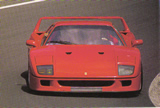
SPECIFICATIONEngine:
V8; 82 x 69.5 mm, 2,936 cc; turbocharged; max power 478 bhp at 7,000 rpm.
Transmission:
Five speed manual gearbox
Suspension:
Independent front and rear by double wishbones, coil springs and dampers
Brakes:
Disc brakes
Dimensions:
Wheelbase: 96.5 in (245cm);
Track: Front, 62.8 in (159 cm);
Rear: 63.4 in (161 cm)
Max speed:
Approx 203.3 mph (324 kmh) |
Ferrari F40 1987
This 40th anniversary car may not wholly practical as a means of transport but it was perhaps the "the" supercar of the late 1980s: a car which Ferrari claimed would cover a kilometre from a standing start in 21 seconds, with a terminal speed of 167.8 mph/269 kmh.
Aerodynamic
Ferrari had used composites in Grand Prix cars and had experimental GT cars using them, before producing the carbon/Kevlar composites body for the F40. Bonded to a tubular frame, it made for an assembly of grear torsional stiffness. Pininfarina's styling was simple and functional, achieving a Cd value of 0.34 despite the prominent rear aerofoil. The cockpit was sparse, hardly in keeping with the car's price tag, and visibility was not outstanding. One of the few concessions to comfort was air-conditioning.
Street racer
Performance in abundance came from the 90-degree mid-mounted and in-line V8 engine with its two IHI water cooled turbochargers. The claimed bhp really became significant when put alongside the cars 2430 lb/1100 kg kerb weight. The acceleration figures underline the power/weight ratio. The production schedule of June 1986 saw the prototype running a year later and eventually produced this amazing street-legal racing car.
From almost any angle, the F40 looks tailor made for a circuit role, while its proportions make it appear smaller than it actually is.
Photo Autopresse
MCMXCI, Edito-Service S.A. D1 078 01-07
|